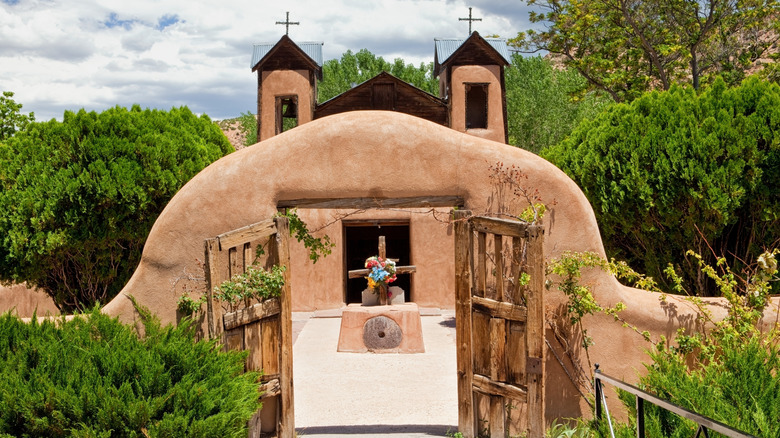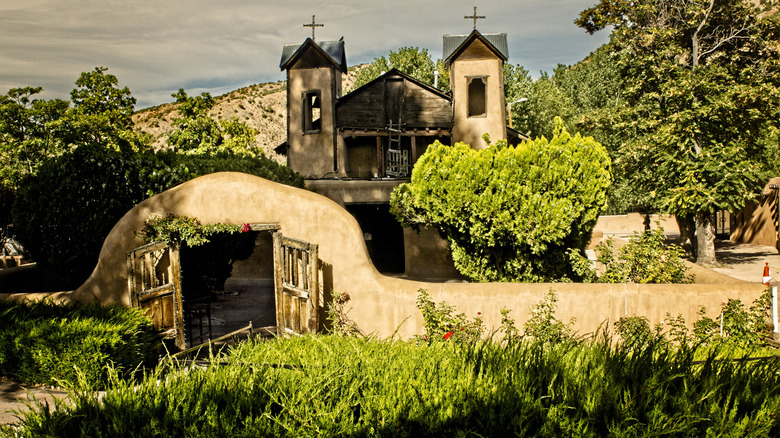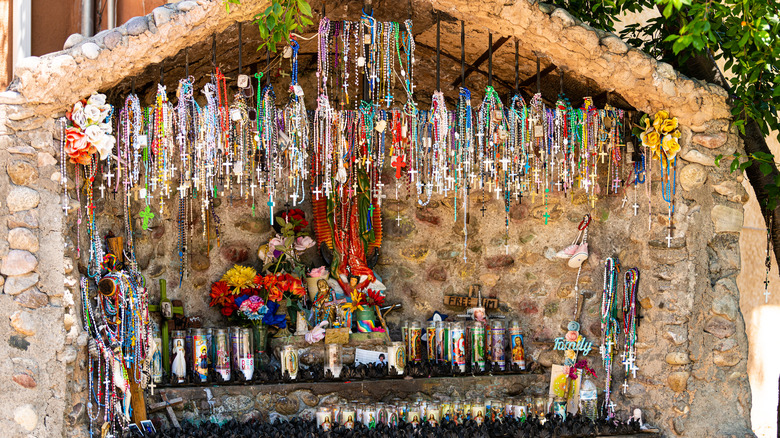New Mexico's Mountains Have A Sacred Destination With Allegedly Magical Healing Soil
Spiritual tourism is a growing travel trend internationally, and many tourists are seeking more meaningful experiences that help them feel connected to their heritage and faith. The American West is home to many popular sacred sites, so it's no surprise that the region attracts travelers who hope to get in touch with their spirituality. From energy vortexes in a red rock oasis to healing hot springs, there are plenty of fascinating destinations believed to help facilitate emotional, spiritual, and physical healing. El Santuario de Chimayo in New Mexico is one of the most historic and a popular pilgrimage site for people who practice Catholicism.
Constructed in 1813, El Santuario de Chimayo is a small adobe-style church complex. Long before a church was built, the land was considered sacred by Indigenous Americans. Surrounded by the Sangre de Cristo Mountains in Chimayo, New Mexico, the small shrine attracts more than 300,000 visitors each year, and the soil on which the church is built is believed to hold miraculous healing powers.
The history of El Santuario de Chimayo
The ancestral Pueblo people were the first to call the region that is now known as New Mexico home. The healing powers of the land were known to them long before Spanish settlers colonized the region. Since the 12th century, the Pueblo and Tewa people lived in harmony with nature, revering the land as sacred. They believed they shared the land with spiritual entities who dwelled within hot springs. When the springs dried up, the earth itself was infused with healing properties.
In 1693, Spanish colonizers gained control of New Mexico, and both Mexican and Spanish settlers began to arrive. The settlers built their homes along the Santa Cruz River and eventually founded a town called El Potrero, where El Santuario de Chimayo would later be built. The settlers soon discovered their own spiritual connection to the land. They performed devotions to a Guatemalan image of Jesus known as Our Lord of Esquipulas, a tradition that originated in Guatemala in a shrine where the dirt was also believed to be sacred. This eventually spread to New Mexico.
During Holy Week in 1810, Don Bernardo Abeyta is said to have witnessed a mysterious light coming out of the earth on a hill near the river. He followed the light and began to dig into the soil until he discovered a crucifix. A priest was notified, and the crucifix was moved to a church in Santa Cruz. Somehow, it found its way back to Chimayo by the next morning. The crucifix was moved a few more times, but each time it returned. Another legend explains that Don Bernardo Abeyta was granted a vision and discovered the healing dirt while plowing his fields. The people of El Potrero built the chapel of El Santuario de Chimayo in 1813 and dedicated it to Our Lord of Esquipulas.
Legends of miracles and healing soil
Many people who have traveled to El Santuario de Chimayo over the years claim they were healed from various ailments after visiting and rubbing their bodies with the healing soil. The stories of healing have never ceased, with many recent examples posted on the El Santuario de Chimayo website. One visitor claims to have been completely cured from ALS after rubbing the healing dirt on his body. Another says that their pesky fingernail fungus completely cleared up after visiting the site. A father that visited with family says the healing power of El Santuario de Chimayo's soil helped his daughter overcome her phobias.
The miraculous stories have attracted visitors from all over the world, many of whom continue to seek out the soil's healing power. Suggested uses of the healing dirt include sitting in silent meditation and prayer before rubbing the dirt over the part of your body in need of healing.
El Santuario de Chimayo is open daily from 9 a.m. until 5 p.m. There is a welcome center, gift shop, and café onsite. There is a daily mass at 11 a.m. and a Sunday mass at 10:30 a.m. Free tours are available on Fridays. Make sure to carve out some extra time to explore New Mexico and visit some of America's coolest desert towns.


